Moldova is a country that most likely you have not heard of. However, once you realize all that this tiny nation has to offer, we hope that your interest will be sufficiently peaked to find out more!
This country is a hidden gem tucked between Romania and Ukraine. It offers an interesting blend of historical sites, monasteries, delicious wines, and off-the-beaten-path adventures with budget travel prices. This Moldova travel guide will unveil the best that this country has to offer. From its chill capital Chisinau to serene monasteries, decadent wineries and two unique breakaway regions which add to the mystique of this country.
Traces of Moldova’s past are evident throughout the country. Having been part of Romania until World War II and the Soviet Union after, this country has a unique blend of influences.
For those seeking off-the-beaten-path adventures mixed with budget travel, this is a dream destination. This often-overlooked country offers a chance to experience genuine solitude (you will most likely be the only tourist there) discovering hidden gems on a budget.
Map of Moldova
Top Places to See
Chisinau

Chisinau Moldova’s capital, offers a delightful mix of history, culture, and green spaces. It has an interesting blend of both European and Soviet feels. There are plenty of restaurants and cafes that are surprisingly budget travel friendly, the streets are clean and there are plenty of things to do for a few days! Here were our favorites:
Take a walk to Cathedral Park to visit the iconic Nativity Cathedral. Here you will also find the Triumphal Arch which was built in 1840 to commemorate the victory of the Russian Empire over the Ottoman one. Cross the street to enjoy Stephen the Great Central Park and grab a coffee in the park. The cafe experience in these parks is an event in itself as they are all decorated with lights and different designs that are quite enchanting in themselves.
A few more streets away is the National History Museum of Moldova where one can spend a few hours. Continue a bit further and take a look at the pretty Saint Theodora of Sihla’s Church. Just past the University of Moldova is the National Museum of Ethnography and Natural History which is worth your while.
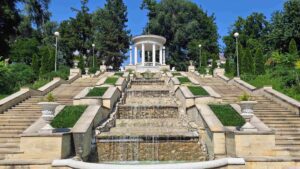
Around the corner are the Cascade Stairs leading to the Valea Morilor Park. The park has a lake in the middle with monuments and fountains around the park. The lake even has a small beach where locals come to sunbathe and swim. It is also a gorgeous area to stroll, grab a coffee or some popcorn (yes, there are popcorn stands within the park) and just relax.
If you enjoy literature, make sure to visit the Alexander Pushkin House-Museum where the exiled Russian poet lived for 3 months. And if poetry is not your thing and you want to do some typical western shopping, then grab a Letz over to MallDova. Yes, the shopping mall is really called that.
But if you are hankering for a real banya experience, then head over to Woloshin Banya on the edge of the forest (12 km from the capital) and enjoy a real sauna/bath/exfoliation, etc., experience in a pretty Moldovean forest.
The Central Market is right in the center of the capital and is very colorful with fruits and vegetables spilling over onto the streets where older ladies sell their berries and foraged wild mushrooms for a budget travel price! It’s a great place to pick up some produce and whatever else you may be looking for.
For an evening treat the National Opera and Ballet Theater will cap off your day with a great cultural experience. This magnificent neoclassical building is home to Moldova’s premier performing arts. Check the schedule for a ballet, opera, or orchestral performance and immerse yourself in the city’s vibrant cultural scene.
Where to Stay in Chisinau:
- Apartment: For budget travel that is very comfortable, we highly recommend staying in one of the apartments close to the center. We stayed in a luxurious 1 bedroom apartment with a full kitchen, air conditioning a washer, high vaulted ceilings etc., which was within a 10 minute walk of Cathedral Park and central restaurants and cafes. The cost was around $55/night as we went through Airbnb. However, you can call Sergei (the apartment operator directly) and negotiate a better price (they have multiple apartments). Sergei’s What’s App: + 373 79456161. There were plenty of options for similar apartments when we booked through Airbnb. Through www.booking.com prices for full 1 bedroom apartments were as low as $5/night.
- Amazing Ionika Hostel: If you are truly enjoying budget travel and perhaps a solo traveler, then this hostel is a lot of fun, is clean and central. A bed in a 6 person dorm room is around $13/night.
PRO TIP: Since Moldova is a small country and you can easily reach most places from the capital city in a day, we decided to use Chisinau as our home base for our 5-day trip.
Where to Eat in Chisinau:
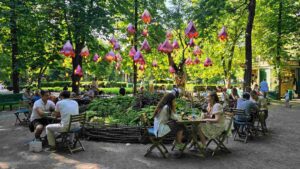
- La Placinte: This stylish cafe serves large portions of traditional Romanian/Moldovian food for $2-3 per plate. From salads to dumplings to cheese pies, meat dishes, grilled vegetable platters and cherry layered strudels – the menu is quite diverse for a hungry appetite that won’t hurt your pocketbook.
- Andy’s Pizza: If it is pizza that you are hankering for, this place offers that plus salads and a lot more. The prices are a bit more than at La Placinte, but are still quite budget friendly with a pizza at $6 USD or so.
- Wiki Bowl Ohana: Great poke bowls in a nice fun atmosphere. The prices are reasonable and there are vegan options.
- For something more upscale head over to Mihai Eminescu Street where there are a few good options (including vegan ones): Sisters, Sincer Cafe (which is a cafe and a gastronomic market) and BIOrganic RAW Café.
PRO TIP: If you are looking for vegan food and the restaurant doesn’t understand the word vegan, then ask for “SHTOTO POSTNOE”
Wineries – Milestii Mici, Cricova
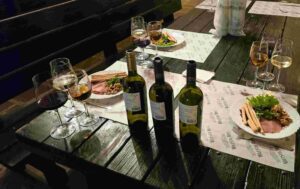
Maldova has been known for it’s rich wine making tradition for centuries. In fact, wine making has been traced back to 3,000 BC in this area. There are over 200 wineries to choose from, but the most popular one and the biggest is Milestii Mici. They offer a unique underground tour at their winery, as it has the world’s largest underground cellar with over 2 million bottles of wine and 200 km of tunnels. Although only 55 km are currently used for storing wine.
We went on a 45-minute “train” tour of the winery’s long tunnels for $25 USD each. These tunnels hold millions of bottles of wine! At the end of the tour, as a souvenir we each received a free bottle of white wine (which Rob enjoyed).
If you’d like to add a wine tasting to your tour, it’s an extra $25 USD per person. This includes a generous amount of wine to try, some appetizers, and the free bottle of white wine at the end. Not exactly budget travel, but once in a while a splurge is well deserved.
The second most popular winery in the country is Cricova Winery. They also offer tours through their tunnels.
Note, that we have 2 other wineries listed in the Transnistria part of this Moldova Travel Guide.
Monasteries – Curchi, Tipova, Saharna
On a day trip to the north of the country we ventured beyond the capital to discover some of Moldova’s most interesting monasteries:
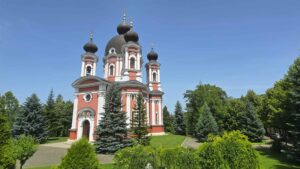
Curchi Monastery was founded over 200 years ago. At one time, it was one of the richest and biggest monasteries in the country. The grounds have several churches built throughout the years, including a wooden church from the 1700s and a grand cathedral built in the 1800s. This main cathedral is the tallest in Moldova with a dome reaching nearly 60 meters (190 feet) high!

Tipova Monastery, dates back to at least the 11th century. It is an impressive cave monastery, carved directly into cliffs overlooking the Dniester river. For a small fee, visitors can hike down the trails to explore several caves, some containing churches, that are connected by steps carved into the rock face. The trail to get to the caves is behind the pretty church on the premises. Keep in mind that the trail is quite steep and is an out and back.
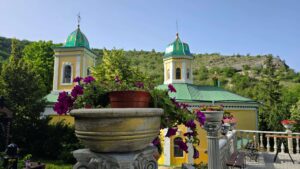
Saharna Monastery dates back to the 15th century and offers a unique experience that blends nature and history. Built directly into a limestone cliff, the monastery appears to seamlessly grow out of the surrounding landscape. As you explore, you’ll encounter caves and grottoes that have served as spiritual retreats for monks for centuries.
A must-see within the monastery complex is the Holy Trinity Church, built in the 18th century. This beautiful church features frescoes and intricate woodwork, showcasing the artistic skill of the period. The property also has a small waterfall and a variety of peacocks and swans that are unfortunately caged.
Soroca Fortress
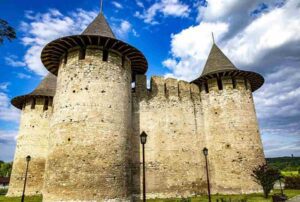
History buffs won’t want to miss the imposing Soroca Fortress, a 15th-century fortification overlooking the Dniester River. Built by Stephen the Great, a Moldavian prince, in 1499, the fortress played a crucial role in defending the country’s borders. Originally constructed from wood, it guarded a strategic crossing point over the Dniester River.
In the mid-16th century, the fortress was rebuilt entirely in stone. This new design featured a perfect circular shape with five bastions (defensive towers). Throughout its history, Soroca Fortress witnessed many battles. It was eventually captured by the Russians during the Russo-Turkish War.
Keep in mind the opening times for the Soroca Fortress Wednesday through Sunday. It is closed Mondays and Tuesdays. Hours are:
- 9:00–12:30
- 14:00–17:30
Transnistria

Transnistria is a narrow strip of land bordering Moldova and Ukraine on the Dniester River. It declared independence from Moldova in 1990 but remains unrecognized by almost all countries. Despite this, Transnistria functions like an independent nation with its own government, military, and currency.
Russia heavily supports Transnistria financially and militarily, keeping the peace with Moldova through a fragile ceasefire. Talks of Transnistria joining Russia worry both Moldova and Ukraine, who fought a brief war with the breakaway state in 1992. Stuck in a state of unresolved conflict since the fall of the Soviet Union, Transnistria remains an unrecognized territory with an uncertain future.
Getting to Transnistria and the Visa
After visiting the monasteries in Moldova we crossed the Dniester River at the Northern border crossing. Driving over the bridge felt like stepping into another world. Googlemaps said that we were still in Moldova (and in the eyes of the Moldovian government we still were). However, we were entering the mystical Transnistria.
At the border, we stopped at a booth where we showed our passports and received some papers we’d need when leaving Transnistria. Continuing a short distance across the bridge, a soldier flagged us down and directed us to a small building. Here, we had to fill out a form called a “vignette” for both the car and the driver. This vignette cost 95 Moldovan Leu, which is roughly equivalent to $5 USD or 5 Euros (all of these currencies are accepted here). The entire process took about 15 minutes.
If you are entering by bus, you will also have to fill out a form, hand it to the guard, and keep your printed visa (which is free). Your visa allows a short stay (12 hours), with extensions possible inside the country. Leaving is even easier – the guard collects your visa on the bus, checking the validity. While most people have no issues, there are rumors of hefty bribes for overstaying.
Puskin to Tiraspol
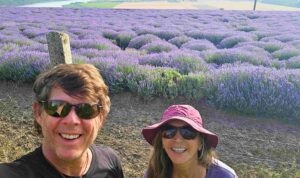
As we drove into the country, it truly felt other worldly. Signs look homemade, guards wear outdated (old USSR) uniforms and don’t chat, and everything is in Russian. However, the main road paralleling the river towards Tiraspol was in excellent shape and properly sealed.
Along the way we stopped at a Lavendar Festival (end of June) where fields were overflowing with purple and local food was in abundance. We were the only tourists there and felt like rock stars.
As the road continued south there were several stops with interesting monuments (tanks and war memorabilia) and Soviet era signs.
Tiraspol
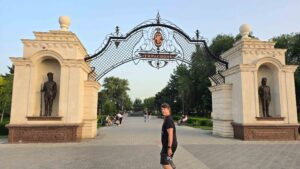
If you’re interested in the Soviet Era, Tiraspol is a must-see. It’s like stepping back in time, almost an open-air museum of the Soviet era. Once there, head towards Catherine the Great Park where you will find the Suvorov Monument. Across the street is the De Wollant Park containing a Tank Monument and the Memorial of Glory.
Strolling down the main boulevard, you’ll find the Tiraspol City Hall and the Republic’s Palace, both still standing guard under the watchful gaze of statues of Lenin. Park Pobeda (Victory) is a great place to walk around in the evening and people watch. The Green Market is a typical market filled with colorful fruits and vegetables.
If you enjoy cognac, then make sure to stop at the Kvint Cognac Distillery where you can taste the cognac and/or purchase it.
PRO TIP: If you enjoy small souvenirs, make sure to exchange some Moldovan Leu for some colorful Transnistrian currency.
Bendery

On our way back to Chisinau, we stopped in Bendery which is only 18 km away from Tiraspol. If you’re interested in history, Bendery is worth a visit for its main attraction: a well-preserved 16th-century Ottoman fortress. This strategic site witnessed fierce battles between the Turks and Russians before becoming part of Russia in the 19th century.
Today, the fortress is open to the public and has a small museum along with stunning views of the river. You can also see some interesting murals on the walls if you leave through the south gate, though be aware that this area is still an active Russian army base and photography is not allowed.
Getting to Bendery Fortress from Tiraspol: The number 19 trolley bus runs frequently between Tiraspol and Bendery, taking about 20 minutes. The first stop after the bridge over the river lets you off near the fortress.
PRO TIP: Keep in mind that entry into the Bendery Fortress is now only through the north gate, which is a bit of a walk. If you’d prefer to avoid the walk, consider taking a taxi to the north gate. You can then exit through the south gate and catch the number 19 trolley bus back to Tiraspol.
Gagauzia
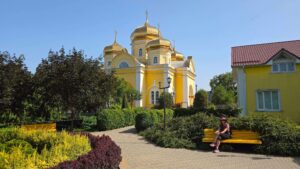
Gagauzia is an autonomous region in southern Moldova. It’s home to the Gagauz people, a Turkic ethnic group with a distinct language and Orthodox Christian faith. Founded in the 1990s after the fall of the Soviet Union, Gagauzia continues to have a complicated relationship with Moldova.
The region enjoys a degree of self-governance and has sometimes clashed with the central government over issues like language and foreign policy. Despite these tensions, Gagauzia remains part of Moldova and offers visitors a chance to experience a unique culture and beautiful landscapes.
Comrat
We quite enjoyed strolling the main streets of Comrat (the capital) of Gagauzia and visiting it’s Central Park. Within the park is the St. John Cathedral, an Orthodox Church where we watched a traditional Gagauzian wedding.
You can also visit the Comrat Regional History Museum and the Central Market of Comrat. Pronto Cafe is a great place to grab a pizza and a drink.
If you enjoy wine tours, then stop in at the Vinuri de Comrat where they have been making wine since 1897.
Besalma
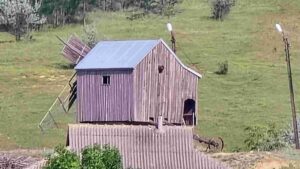
Driving further south from Comrat to Besalma, we stopped to take a look at the famous Wooden Windmill. The mill was built on the highest elevation of the village, in the middle of the 19th century and is representative of the wooden architecture in the Gagauzian region.
Vulcanesti – South Gagauzia
In the village of Vulcanesti is the award winning KaraGani Winery which produces about 10,000 bottles of wine per year and is considered to be the best wine of the region.
Logistics

BEST TIME TO VISIT
The best time to visit Moldova depends on your preferences. Spring and autumn offer pleasant weather and fewer crowds, while summer is perfect for beach lovers (river and lake beaches) and festival goers. Winter provides a unique perspective with festive celebrations and even better budget-travel.
Pro Tip: Consider combining seasons for a unique experience. For instance, visit in late spring to witness blooming landscapes and participate in Easter traditions, or plan a trip in early autumn to enjoy the charming fall foliage and partake in the wine harvest festivities.
SAFETY
When we visited and at the time of writing, all travel advisories were at the cautionary level – Exercise a High Degree of Caution. This is for Moldova overall and is due to the volatile security situation and the impacts of military conflict in neighboring Ukraine. We were aware of this and made a conscious decision based on the information that we had from trusted news channels and our tolerance for risk.
I mean hey, we have visited Afghanistan, Mali, Sudan, and some other risky places. All of these quests were based on deep research, conversations with people on the ground balanced with our sense for adventure.
Having said all that, we felt extremely safe in this country including in the breakaway regions of Transnistria and Gagauzia. There wasn’t a moment when we felt unsafe. We even walked the streets of Chisinau in the dark (something that we never do in other parts of the world).
Ultimately, the decision to travel here (or to any other potentially risky travel destination) rests with you and your personal tolerance for risk.
CURRENCY
The leu is the currency in this country. At time of writing, $1 USD was worth about 18 leu. ATMs are readily available and most stores and restaurants accept international credit cards. For our 5 days in Moldova we took $70 USD out from an ATM and by the end of day 5 had barely used $20.
Keep in mind that the breakaway region of Transnistria uses the Transnistrian ruble. At time of writing, $1 USD was worth about 16.3 Transnistrian rubles.
TOURIST VISA
Many passport holders do not require a tourist visa to visit Moldova for up to 90 days within a 180 day period. You can find the Moldova visa policy here.
CONNECTIVITY: SIM/ESIM CARDS
Connectivity in this country is easy, readily available and inexpensive. For a SIM card, we recommend getting one from Orange, Moldcell or Moldtelecom. We got the Moldcell SIM card at the airport and only paid $5.50 USD for 40 GB of data valid for 4 weeks.
If you prefer to arrive into the country and have data flowing through your cellphone immediately, then consider getting an eSIM from Airolo. However, the cost is much higher than that of the SIM cards mentioned above.
TRANSPORTATION
There are a few options for transportation throughout the country. We chose to rent a car and found the process to be quite straight forward. Here are some options that you can choose from depending on your style of travel:
Trains:
- Limited Network: Moldova’s railway system is not as extensive as some European countries. It primarily connects major cities like Chisinau, Balti, and Ungheni.
- Long Distances: Trains can be a good option for covering long distances within Moldova, but be prepared for potentially slower travel times compared to other options.
- Information and Booking: Check the Moldovan Railways website for timetables, routes, and ticket booking information.
Taxis and Rideshares:
- Readily Available: Taxis are a convenient option for getting around cities like Chisinau, especially at night or with heavy luggage.
- Negotiate Fares: It’s customary to negotiate a fare with the taxi driver before your journey.
- Ridesharing App: Letz is the best ride-sharing app in the country. It requires a local phone number which you will receive with your SIM card.
Buses and Marshrutkas:
- Extensive Network: This country has a well-developed network of buses and minibuses called “marshrutkas.” These connect cities, towns, and villages, offering a budget-friendly way to travel. Chisinau has 3 bus terminals: North (use if traveling to the North of the country), Central (if traveling internationally or to Transnistria) and Sud (if traveling to the south including Gagauzia).
- Purchasing Tickets: Tickets can be purchased from the kiosk inside of the bus terminal (some credit cards are accepted). However for marshrutkas, tickets are typically purchased directly from the driver on board of the small bus.
- Limited Schedules: Be aware that some routes, especially in rural areas, may have limited schedules. Research timetables beforehand if possible, or ask locals for guidance.
Renting a Car:
- Freedom and Flexibility: Renting a car offers the most flexibility for exploring off-the-beaten-path destinations here.
- Road Conditions: Road conditions can vary, however we found the roads to be in good condition and quite smooth throughout. Especially in Transnistria!
- International Driving Permit: Although we always carry our International Driving Permit, it was not necessary when we rented our car from Sixt. They only required a valid drivers license.
Additional Tips:
- Limited English: Be prepared that English may not be widely spoken, especially outside of Chisinau. Learning a few basic phrases in Romanian or Russian can be helpful.
Wrap Up
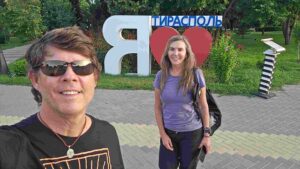
Despite being a lesser-known tourist destination, Moldova has a lot to offer visitors. From monasteries to award winning wineries, to fortresses and intriguing break away regions. For us, this tiny nation was a wonderful off the beaten path destination where we didn’t see a single tourist during our 5 day stay. And our money went such a long way here! So we think of Moldova as budget travel with a lot of comfort thrown in.
In summery, this hidden gem promises a unique blend of history, nature, and delicious wines, leaving you with unforgettable memories. We hope that our Moldova Travel Guide helps your adventure through this lovely country.
Have you been to Eastern Europe? What was your favorite destination? We would love to hear from you in the comments.

